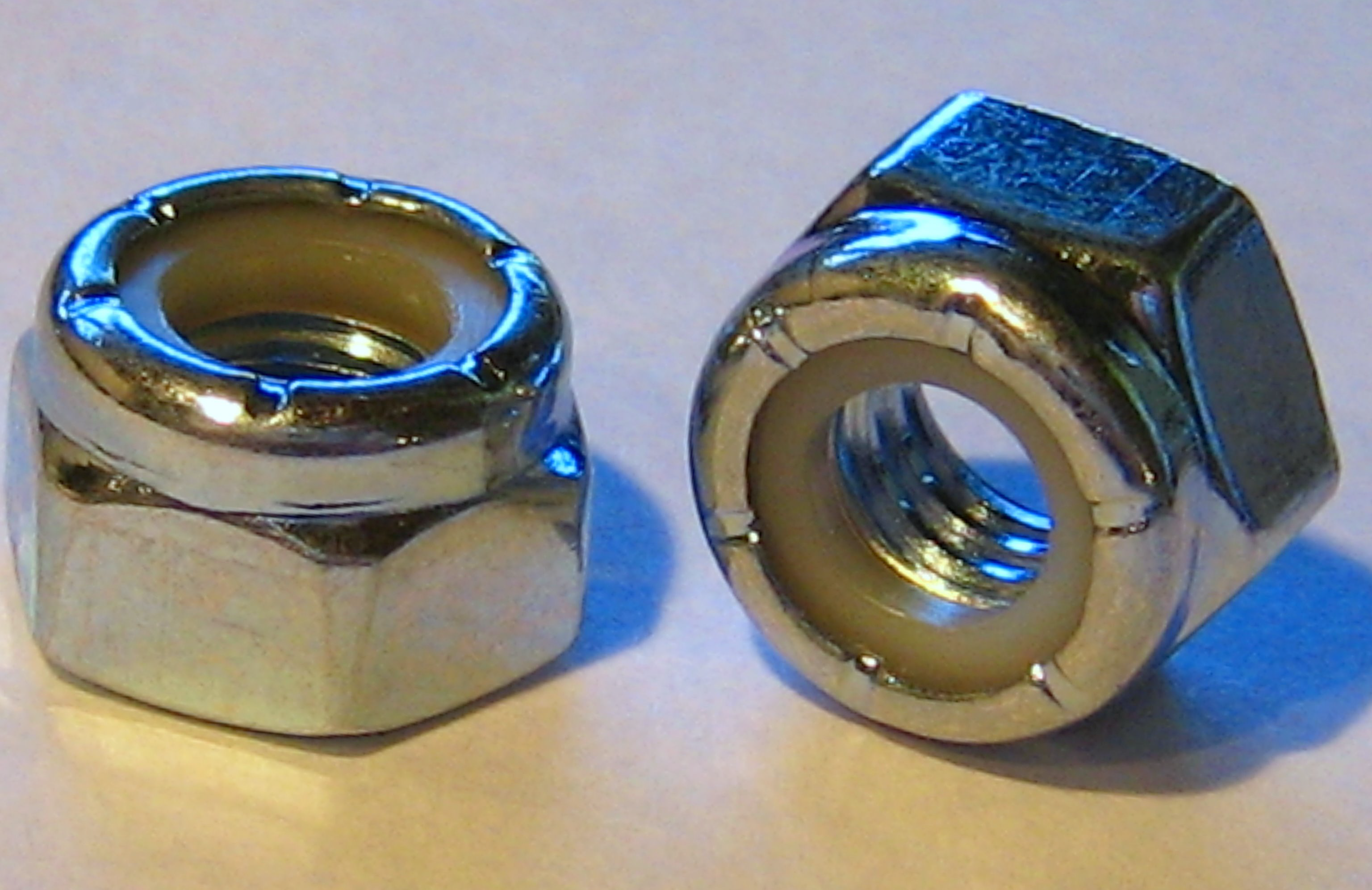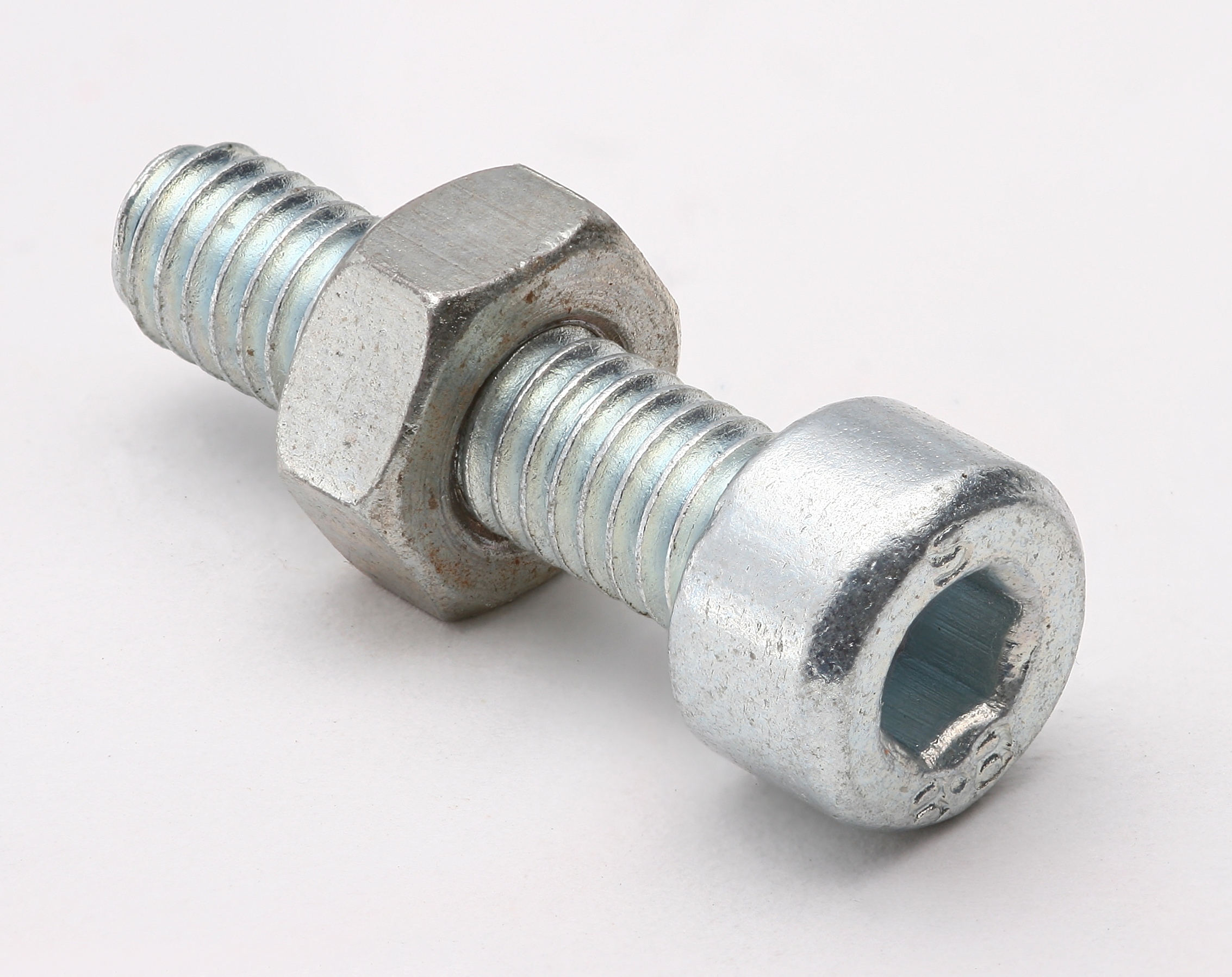|
Toplock Nut
A distorted thread locknut,McMaster, p3139 is a type of locknut that uses a deformed section of thread to keep the nut from loosening from vibrations or rotation of the clamped item. They are broken down into four types: elliptical offset nuts, centerlock nuts, toplock nuts and partially depitched (Philidas) nuts. High temperature use Because these nuts are solid metal, they are effective in elevated temperature settings, unlike nyloc nuts. High grade nuts can withstand temperatures up to . Safety factors High strength distorted thread nuts cannot be used with low strength fasteners because the hard nut will act like a die and destroy the threads on the fastener. Elliptical offset nuts Elliptical offset nuts is a catch-all category that encompasses designs known as oval locknuts or non-slotted hex locknuts,. The salient feature is that the thread form has been deformed at one end so that the threads are no longer perfectly circular. The deformed end is usually shaped into an ellip ... [...More Info...] [...Related Items...] OR: [Wikipedia] [Google] [Baidu] |
Locknut
A locknut, also known as a lock nut, locking nut, self-locking nut, prevailing torque nut,. stiff nut or elastic stop nut, is a nut that resists loosening under vibrations and torque. Prevailing torque nuts have some portion of the nut that deforms elastically to provide a locking action. Free-spinning locknuts exist which carry the advantage of not requiring extra torque until seated. Types There are various kinds of specialised lock nuts, including: * Castellated nut * Distorted thread locknut ** Centerlock nut **Elliptical offset locknut ** Toplock nut **Philidas nut * Interfering thread nut ** Tapered thread nut * Jam nut * Jet nut (K-nut). * Keps nut (K-nut or washer nut) with a free-spinning washer. In the locknut form, this is a star-type lock washer. * Plate nut * Polymer insert nut (Nyloc nut) * Security locknut All steel reusable nut for high vibration and harsh environments. * Serrated face nut * Serrated flange nut * Speed nut (sheet metal nut or Tinnerman nu ... [...More Info...] [...Related Items...] OR: [Wikipedia] [Google] [Baidu] |
Screw Thread
A screw thread, often shortened to thread, is a helical structure used to convert between rotational and linear movement or force. A screw thread is a ridge wrapped around a cylinder or cone in the form of a helix, with the former being called a ''straight'' thread and the latter called a ''tapered'' thread. A screw thread is the essential feature of the screw as a simple machine and also as a threaded fastener. The mechanical advantage of a screw thread depends on its ''lead'', which is the linear distance the screw travels in one revolution. In most applications, the lead of a screw thread is chosen so that friction is sufficient to prevent linear motion being converted to rotary, that is so the screw does not slip even when linear force is applied, as long as no external rotational force is present. This characteristic is essential to the vast majority of its uses. The tightening of a fastener's screw thread is comparable to driving a wedge into a gap until it sticks fast thro ... [...More Info...] [...Related Items...] OR: [Wikipedia] [Google] [Baidu] |
Nut (hardware)
A nut is a type of fastener with a screw thread, threaded hole. Nuts are almost always used in conjunction with a mating bolt (fastener), bolt to fasten multiple parts together. The two partners are kept together by a combination of their threads' friction (with slight deformation (engineering)#Elastic deformation, elastic deformation), a slight Tension (physics), stretching of the bolt, and compression (physics), compression of the parts to be held together. In applications where vibration or rotation may work a nut loose, various locking mechanisms may be employed: lock washers, jam nuts, eccentric double nuts, specialist adhesive thread-locking fluid such as Loctite, safety pins (split pins) or lockwire in conjunction with castellated nuts, nylon inserts (nyloc nut), or slightly oval-shaped threads. Square nuts, as well as bolt heads, were the first shape made and used to be the most common largely because they were much easier to manufacture, especially by hand. While rare to ... [...More Info...] [...Related Items...] OR: [Wikipedia] [Google] [Baidu] |
Nyloc Nut
A nyloc nut, also referred to as a nylon-insert lock nut, polymer-insert lock nut, or elastic stop nut, is a kind of locknut with a nylon collar that increases friction on the screw thread. The nylon collar insert is placed at the end of the nut, with an inner diameter (ID) slightly smaller than the major diameter of the screw. The screw thread does not cut into the nylon insert, however, the insert deforms elastically over the threads as tightening pressure is applied. The insert locks the nut against the screw as a result of friction, caused by the radial compressive force resulting from the deformation of the nylon. Nyloc nuts retain their locking ability up to . Trademark There are no registered trademarks filed in the United States for "Nyloc" or "Nylock" that are currently active in regards to fasteners. In Australia, "nyloc" is a registered trademark. Related fasteners A nylon pellet nut is very similar to a nyloc nut except that it uses one or more smaller nylon inserts i ... [...More Info...] [...Related Items...] OR: [Wikipedia] [Google] [Baidu] |
Bolted Joint
A bolted joint is one of the most common elements in construction and machine design. It consists of a male threaded fastener (e. g., a bolt) that captures and joins other parts, secured with a matching female screw thread. There are two main types of bolted joint designs: tension joints and shear joints. Joint types In a tension joint, the bolt and clamped components of the joint are designed to transfer an applied tension load through the joint by way of the clamped components by the design of a proper balance of joint and bolt stiffness. The joint should be designed such that the clamp load is never overcome by the external tension forces acting to separate the joint. If the external tension forces overcome the clamp load (bolt preload) the clamped joint components will separate, allowing relative motion of the components. The second type of bolted joint transfers the applied load in shear of the bolt shank and relies on the shear strength of the bolt. Tension loads on such ... [...More Info...] [...Related Items...] OR: [Wikipedia] [Google] [Baidu] |
Tap And Die
Taps and dies are tools used to create screw threads, which is called threading. Many are cutting tools; others are forming tools. A tap is used to cut or form the female portion of the mating pair (e.g. a nut). A die is used to cut or form the male portion of the mating pair (e.g. a bolt). The process of cutting or forming threads using a tap is called ''tapping'', whereas the process using a die is called ''threading''. Both tools can be used to clean up a thread, which is called ''chasing''. However, using an ordinary tap or die to clean threads generally removes some material, which results in looser, weaker threads. Because of this, machinists generally clean threads with special taps and dies—called ''chasers''—made for that purpose. Chasers are made of softer materials and don't cut new threads. However they still fit tighter than actual fasteners, and are fluted like regular taps and dies so debris can escape. Car mechanics, for example, use chasers on spark plug th ... [...More Info...] [...Related Items...] OR: [Wikipedia] [Google] [Baidu] |
Elastic Deformation
In engineering, deformation refers to the change in size or shape of an object. ''Displacements'' are the ''absolute'' change in position of a point on the object. Deflection is the relative change in external displacements on an object. Strain is the ''relative'' internal change in shape of an infinitesimally small cube of material and can be expressed as a non-dimensional change in length or angle of distortion of the cube. Strains are related to the forces acting on the cube, which are known as stress, by a stress-strain curve. The relationship between stress and strain is generally linear and reversible up until the yield point and the deformation is elastic. The linear relationship for a material is known as Young's modulus. Above the yield point, some degree of permanent distortion remains after unloading and is termed plastic deformation. The determination of the stress and strain throughout a solid object is given by the field of strength of materials and for a structure ... [...More Info...] [...Related Items...] OR: [Wikipedia] [Google] [Baidu] |
Philidas
Philidas Ltd. (previously named Infast Philidas) is a company based in Pontefract, West Yorkshire, England that manufactures nuts and components for automotive and industrial applications. History The company was established in 1942, and is a branch of the Haden MacLellan engineering group. Prior to this the company was a part of B Elliott, which sold Philidas to Haden MacLellan in 2000. Philidas manufactures automobile fasteners in both small and large-scale batches. The company's products are distributed on a global basis. In 2005, it was reported that the company manufactures 110 million fasteners annually. Philidas had a factory on Monkhill Lane, Pontefract. But this closed in January 2014. Some of Philidas' clients include BMW, Jaguar, Ford and Bosch. Philidas nut A Philidas nut is a locknut with one or more slots cut laterally in the reduced-diameter circular top for less than half the diameter, the metal above the slot(s) being deformed downwards so that over the last one ... [...More Info...] [...Related Items...] OR: [Wikipedia] [Google] [Baidu] |
Split Beam Nut
A split beam nut, also known as a split hex nut. or slotted beam nut, is a locknut with slots cut in the top that separate the outside end into two. or more sections that are bent slightly inward, making the thread diameter undersized in the slotted portion. As the nut is threaded on, these sections are forced back out to their original position and increase the friction between the nut and the fastener, creating the locking action. High temperature use High strength grades retain their locking ability up to , unlike nyloc nuts. Military grade nuts can be reused at least a dozen times.Smith, p. 105 Trademark Aerotight is a tradename for a specific type of split beam nut. Other names for this type of nut are stiff nut and Allmetal self locking nut. See also *Elliptical offset locknut A distorted thread locknut,McMaster, p3139 is a type of locknut that uses a deformed section of thread to keep the nut from loosening from vibrations or rotation of the clamped item. They are br ... [...More Info...] [...Related Items...] OR: [Wikipedia] [Google] [Baidu] |




